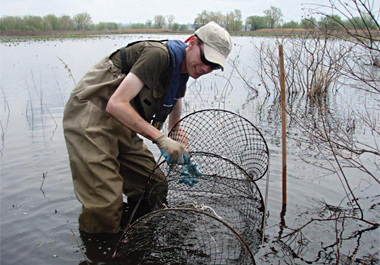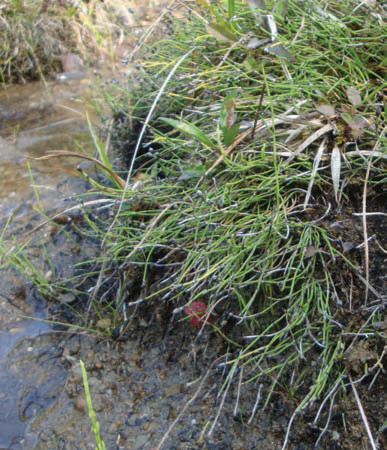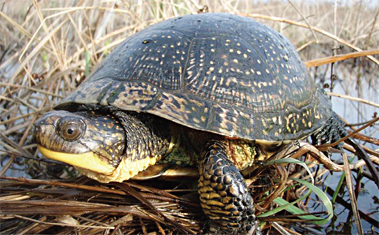Erie County Treasures

The elusive Blanding’s turtle was discovered in Erie County by Ryan Miller, assistant zoologist for WPC.
Western Pennsylvania Conservancy scientists initially had no idea that a scruffy-looking wetland near railroad tracks in Erie County would contain rare plants, including one never documented before in Pennsylvania.
Nor did they expect to find, in French Creek, northern redbelly dace, a type of minnow believed to have disappeared from the Commonwealth about 150 years ago. But these ecological treasures, as well as Blanding’s turtle, were discovered during surveys to update the Erie County Natural Heritage Inventory — the first in 16 years — and are the latest additions to the Pennsylvania Natural Diversity Inventory database. The Erie County inventory, an extensive catalogue of plant and animal species in the county, was one of five county inventories carried out this summer and 60 completed by WPC to date.
“It’s very exciting to find species thought not to exist in Pennsylvania,” said Shaun Fenlon, WPC’s vice president for conservation programs and services. “It highlights the importance of the ongoing work our scientists and partners perform.”
The three-acre wetland where the plants were found last August is on the grounds of the future Mercyhurst College West. A tip from Mercyhurst biology professor Mike Campbell about sundew plants growing there prompted WPC ecologists Christopher Tracey and Peter Woods to explore an area they otherwise might have bypassed. “The site actually looked pretty bad around the edges, but sundew indicates unique habitat. It’s typically associated with peatdominated wetlands such as bogs or fens — so we decided to take a look,” he said. A survey turned up seven rare species, including dwarf scouring rush, part of a family of silicate-rich horsetails once used for scrubbing pots, and previously unknown in Pennsylvania.

WPC scientists identified dwarf scouring rush, a wiry-looking plant, in Girard.
The others were yellow sedge, slender spike-rush, thin-leaved cottongrass, short-fruited rush, broad-leaved willow, and hooded ladies’-tresses, which is a tiny orchid. All are unique to nutrient-rich seepage wetlands, adding another dimension to the Erie discovery. “This type of habitat wasn’t known to occur in the Lake Erie basin, so it has given us something else to look for,” Tracey said. “One of the really big lessons we learned from this is that not all important sites are out in the wild.”
Even thoroughly studied habitats can yield dramatic surprises, as the discovery of northern redbelly dace in French Creek illustrates.
Large numbers of this colorful minnow were recently found in slow-moving sections of the French Creek watershed by Rob Criswell, an ichthyologist, or fish scientist, who performed surveys for WPC under contract. Whether the dace have always been there or are moving from Brokenstraw or Conewango Creeks may never be known, Tracey said. “While it’s likely that there has never been a survey for them in this area, they also might have been misidentified in the past — or someone may have figured out what they were but not understood their importance.
“In either case, fish of this kind were last collected in Pennsylvania in the early 1860s in the Susquehanna River basin, Susquehanna County, so finding them in French Creek is significant.”
The Blanding’s turtle — a ten-inch reptile with a distinctive yellow throat and neck — was thought to have largely disappeared from Pennsylvania, too, until WPC Assistant Zoologist Ryan Miller trapped four, including three females, in Erie County last spring. “I was very surprised to find any. Finding two in one day made me ecstatic,” said Miller, whose team of volunteers helped set up to 70 traps that were checked every 24 hours. All trapped turtles were quickly returned, unharmed, to their original locations. “What it tells us is, yes, there are turtles, and they could be mating, although we have no evidence of that. We didn’t trap any juveniles yet. But we’re hoping to continue with more surveys.”
The project was funded through the State Wildlife Grants program and the Fish and Boat Commission. Miller seeks additional funding for radio telemetry studies, which would enable scientists to further track the turtles.

Blanding’s turtle.
Blanding’s turtles are elusive creatures with specific habitat needs. “They’re secretive — they don’t bask — and they prefer shrubby, boggy areas,” Miller said. “We know they travel as seasons progress, crossing roads and trails to find suitable water.”
Miller said the Presque Isle Bay turtles may be washing in from elsewhere or they may have been there, undiscovered, all along. “This is dead-center in their native range and we’re trying to determine whether the population is viable or not,” he said. “We’re encouraged by our findings so far.”
Another plant species was rediscovered in September in Erie County by Jim Bissell, the botanical curator at the Cleveland Museum of Natural History, whose discoveries over the years have greatly contributed to the Erie County Natural Heritage Inventory. No one had seen the southern woodrush in Pennsylvania since 1971, and the only previously known sites were in the southern edge of the state, but Bissell had been keeping an eye out for it in open, sandy habitats. He finally found the plant on a sandy knoll, a remnant of an offshore dune dating to the end of the ice age.
Data collected on these and other species are used by state and federal natural resource agencies to make decisions about managing rare plants and animals. The public also can access this information at www.paconserve.org/123.
